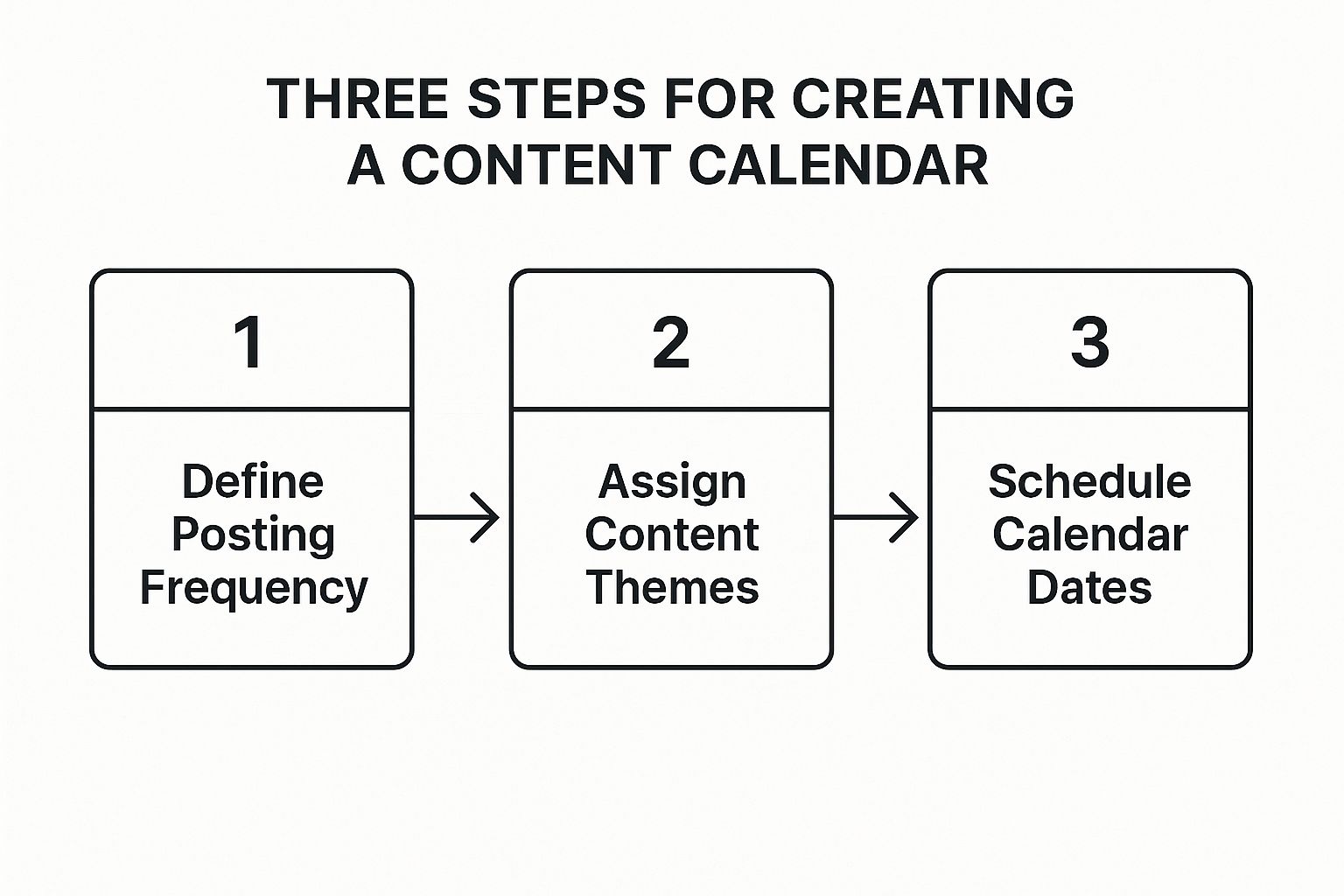So, what does it actually mean to batch social media content? It’s pretty simple: you’re setting aside dedicated chunks of time to hammer out specific creative tasks in bulk. Think of it as writing all your captions for the week in one sitting or filming all your video clips for the month in a single afternoon.
It’s a strategic pivot away from the daily, chaotic scramble for content and toward a structured, creative system. The real win? You reclaim hours of your time while actually improving the quality of what you post.
The Power of a Batching Workflow
Imagine your social media process for a moment. Right now, it might feel like a reactive, day-to-day grind. Now, picture it as a calm, organized, and creative powerhouse. That's the real change you get when you fully commit to a batching workflow.
This isn’t just some productivity hack you read about once. It's a fundamental shift in how you approach content creation. You stop thinking in terms of one-off tasks and start building a streamlined system.
Escape the Daily Content Treadmill
That constant, nagging pressure to post something—anything—every single day? It’s a fast track to creative burnout and, frankly, mediocre content.
Batching is the antidote. By dedicating specific, uninterrupted blocks of time to one type of task, you find your focus. For example, you could block off two hours on a Monday morning to write every single caption you'll need for the next two weeks. Then, on Tuesday, you might spend a few hours designing all the graphics to go with them.
This approach lets you get into a state of creative flow. Instead of your brain constantly switching gears between writing, designing, and filming, it stays locked in on a single activity. The result is almost always better, more cohesive work. It’s the difference between an efficient assembly line and trying to build a car one random piece at a time.
Batching isn't just about scheduling posts. It’s a strategic mindset that frees up your mental energy for what really matters: engaging with your community and actually growing your brand.
Maintain Consistency and Quality
Showing up consistently is non-negotiable if you want to stay visible. With over 5.45 billion people on social media spending an average of 2 hours and 24 minutes there every day, you can't afford to go quiet.
Batching ensures you always have a pipeline of high-quality, on-brand content ready to publish. It's your safety net against those last-minute, rushed posts that you regret as soon as you hit "publish."
When you plan a whole month of content at once, you get a bird's-eye view of your strategy. You can see the big picture, maintain a consistent brand voice, and make sure you have a healthy mix of content pillars. This high-level perspective prevents your feed from becoming repetitive and keeps your audience genuinely engaged. If you want to dive deeper, check out these content marketing statistics to see how top brands use consistency to their advantage.
At its core, batching is about creating the right conditions for your best work. Here's a breakdown of the key components that make it so effective.
The Core Pillars of Effective Content Batching
This table summarizes the fundamental components of a successful content batching system, outlining the purpose and key action for each stage.
| Pillar | Purpose | Key Action |
|---|---|---|
| Ideation | To generate a high volume of content ideas without pressure. | Hold a dedicated brainstorming session to fill your content calendar with topics, formats, and angles. |
| Creation | To produce all content assets in focused, single-task sessions. | Block out separate times for writing, filming, and designing. Don't mix tasks. |
| Organization | To create a "single source of truth" for all scheduled content. | Use a tool (like a spreadsheet or project manager) to house all captions, media, and publishing dates. |
| Scheduling | To load all approved content into a scheduler for automated publishing. | Use a unified API tool like LATE to schedule everything across all platforms in one go. |
By mastering these four pillars, you build a resilient system that works for you, not against you.
Ultimately, this workflow is your ticket to producing higher-quality work, avoiding burnout, and building a sustainable content engine that fuels your long-term growth.
Building Your Strategic Content Foundation

Before a single caption is written or one graphic is designed, you need a plan. Seriously. This is what separates a chaotic, reactive social media account from one that feels intentional and powerful. Without this foundational work, batching content is just an organized mess, not an efficient system.
This isn't about boxing yourself into a rigid, complicated document. It's about setting up guide rails that make every future decision simpler and faster. Think of it like a chef doing their mise en place—prepping all the ingredients before the cooking starts. It makes the whole process smoother.
Define Your Core Content Pillars
First things first: you need content pillars. These are the 3-5 core themes your brand will own and talk about consistently. They're your North Star, ensuring every single post is on-brand and pushing you toward your business goals.
Let's say you're a fitness app. Your pillars might look something like this:
- Quick Workouts: Simple, effective exercises people can do anywhere.
- Nutrition Tips: Healthy recipes and meal prep hacks.
- Member Spotlights: Real user success stories to foster community.
- Mindset & Motivation: Encouragement and mental wellness advice.
Pillars stop you from posting random thoughts. They create a reliable structure that your audience learns to expect and value, which is how you turn casual followers into a real community.
A common mistake I see is picking pillars that are way too broad. "Marketing" isn't a pillar; "No-Code Automation for Marketers" is. Get specific. Specificity is what attracts the right audience and establishes you as an authority.
Once you’ve locked these in, every piece of content you batch should slot neatly into one of these categories. This is a non-negotiable part of learning how to batch social media content without losing your mind.
Conduct a Quick Content Audit
You’re not starting from scratch. Your existing content is a goldmine of data just sitting there. A quick audit will tell you what’s already working, so you can stop guessing and start doubling down on your winners.
Go look at your analytics from the last 90 days and find your top-performing posts. For each one, ask:
- What was the format? (e.g., carousel, Reel, single image)
- Which pillar did it belong to?
- What was the call-to-action (CTA)?
You'll start seeing patterns immediately. Maybe your audience devours your educational carousels but scrolls right past your single-image quotes. That insight is pure gold for your next content batch, saving you from wasting hours on stuff that's destined to flop. For a much deeper dive on this, check out our guide on planning social media posts.
Brainstorm Ideas Without Limits
Okay, now for the fun part. With your pillars defined and your audit done, open up a spreadsheet or a blank document and just let loose with a "brain dump." For each of your pillars, list every single post idea you can think of.
Don't filter yourself yet. The goal here is pure quantity. Jot down common customer questions, industry myths you can bust, behind-the-scenes ideas, or timely trends. Aim for at least 10-15 ideas per pillar. This creates a content reservoir that ensures you never have to stare at a blank screen wondering what to post next.
Your Content Creation Assembly Line
This is where you stop just making content and start producing it. The secret lies in treating content creation like an assembly line, a technique that has completely changed how I manage my own social media. You’ll unlock a level of efficiency you didn't think was possible.
Forget the old, chaotic way of taking one post from a random idea all the way to hitting "publish." It's incredibly inefficient. Think about it: you wouldn't bake a single cookie by mixing a tiny bit of flour, then a pinch of sugar, and then one chocolate chip. You mix all the dough at once. The exact same idea applies here.
When you block out time for just writing captions, you get into a copywriting flow. When you switch gears to design graphics, you're completely immersed in a visual, creative headspace. This methodical approach isn't just about speed; it produces higher-quality, more cohesive work because you're not constantly forcing your brain to switch contexts.
Grouping Tasks for Maximum Flow
First things first: break down the entire content creation process into distinct stages. This is the foundation of learning how to batch social media content properly. Instead of seeing one big task like "make a post," you see the smaller, individual components.
Here’s how I typically group my tasks:
- Scripting & Writing: I’ll dedicate a whole session to writing out every caption, video script, and bit of text overlay for the entire batch. No visuals, no scheduling—just writing.
- Visual Production: In a completely separate block of time, I'll film all my video clips or do a single photoshoot for all the static images I need.
- Graphic Design: I'll fire up Canva and knock out all the carousels, quote cards, and other graphics in one sitting, usually leaning heavily on my pre-made templates to speed things up.
- Editing & Finalization: Finally, I set aside time to edit all the videos and photos, add music or voiceovers, and get everything prepped for upload.
By isolating these tasks, you can hit that state of deep work, or "flow," making each step feel smoother and more effective. You aren’t working harder; you're just working smarter.
Leveraging Tools and Templates
A good assembly line needs the right tools to keep it running without a hitch. Honestly, creating a set of versatile templates is one of the most powerful things you can do for your workflow. For example, having a few core graphic templates for each of your content pillars means you can just plug in new text and images for each batch. It’s a game-changer.
This simple infographic below shows how to map your ideas to a calendar, which is basically the blueprint for your creation day.

This flow—from defining your posting frequency all the way to scheduling dates—gives your assembly line the structure it needs to actually work.
And of course, we can't ignore the elephant in the room: AI. Today's AI tools can be a massive help in this streamlined model. I use them to get past writer's block by generating initial caption ideas or suggesting hooks, which frees me up to handle the more creative, strategic work. It’s no surprise that 50% of creators are now using AI to give their content a boost.
Batching also gives you the mental space to tackle more ambitious formats. For example, infographics are read 30 times more than plain text articles. When you're not in a constant state of content panic, you have the bandwidth to create them. You can explore more content marketing statistics like this to see what's working.
Pro-Tip: Source all your visuals in bulk. Whether you’re grabbing images from a stock photo library or using shots from your own photoshoot, get every single image and video clip into one organized folder before you start writing or designing. This single step prevents a massive workflow bottleneck down the line. Trust me on this one.
This structured, assembly-line approach turns a process that feels chaotic and overwhelming into a predictable, manageable system. You'll not only claw back countless hours but also find that your creativity actually thrives when it has the space to focus on one thing at a time. This is the real core of a successful content batching system.
Mastering Your Scheduling and Automation

You’ve done the heavy lifting—the brainstorming, the writing, the creating. Now comes the most satisfying part: putting your entire content machine on autopilot. This is where all that upfront work really pays off, freeing you from the daily grind of logging in and posting manually.
With a library of approved, ready-to-go content, the goal is to load it all up and let the technology take over. This final phase of learning how to batch social media content is what turns your organized assets into a living, breathing content calendar that works for you 24/7.
Choosing the Right Scheduling Tool
Your scheduling tool is the engine of your entire batching workflow. Sure, you could post natively to each platform, but that completely defeats the purpose of batching for efficiency. You need a centralized dashboard where you can see and manage everything at once.
When you're looking at different tools, focus on the features that will genuinely save you time:
- Unified Platform Support: Does it handle all your key channels? A tool that covers Instagram, TikTok, and LinkedIn in one spot is infinitely more valuable than juggling three separate schedulers.
- Bulk Uploading: Can you upload your entire batch of content—visuals and all—in one go? For anyone serious about batching, this is a non-negotiable feature.
- Visual Calendar View: A drag-and-drop calendar gives you a bird's-eye view of your upcoming posts. It makes spotting gaps or reshuffling content on the fly incredibly simple.
Tools like LATE are built specifically around this idea, offering a single API to push content to all the major networks. This approach cuts out the headache of managing a dozen different integrations and ensures your carefully batched content gets delivered without a hitch.
Building Your Master Content Calendar
Your scheduling tool is where your abstract plan becomes a concrete reality. Start by uploading all the visuals and captions from your content batch. Seeing it all laid out visually is the best way to check for a healthy mix of your content pillars throughout the week or month.
This is also the perfect time to get strategic with your posting times. The "half-life" of a social media post—how long it stays relevant—varies wildly between platforms. For example, the lightning-fast content cycle on TikTok demands a steady stream of new posts, which is easy to manage when you've scheduled a whole batch of videos and captions in advance. You can find more social media statistics on Sprout Social to see just how much post longevity differs across networks.
The most freeing moment in this entire process is seeing a full month of high-quality content scheduled and ready to go. It’s the ultimate payoff, giving you back hours of your week to focus on engagement, strategy, and other high-impact tasks.
Once everything is loaded and scheduled, your job is pretty much done. The system will now work for you, publishing your content at the best possible times to maximize its reach and engagement. For anyone wanting to really master this step, our in-depth guide offers more tips on https://getlate.dev/blog/how-to-schedule-social-media-posts effectively. This automated process is the final piece of the puzzle, allowing you to show up consistently for your audience without the daily stress.
How to Refine and Optimize Your Workflow

Here’s a hard truth: a great batching system isn't something you just set and forget. It's a living process. Once your initial workflow is humming along, the real work begins—turning it from an organizational tool into a high-performance engine for growth. This is where you graduate from simply being prepared to being truly strategic.
The secret is building a solid feedback loop. Your content goes out, you gather the data, and that data directly tells you what to create in your next batch. It's a continuous cycle of improvement, and frankly, it's what separates the amateurs from the pros.
Track What Truly Matters
You can't improve what you don't measure. It’s time to stop obsessing over vanity metrics like follower count and zero in on the Key Performance Indicators (KPIs) that reveal what your audience actually finds valuable. This data is the cheat code for making your next content batch an absolute home run.
For every post you publish, start tracking these core metrics:
- Engagement Rate: Comments, shares, and especially saves tell you so much more than likes. A post with a high number of saves is a loud and clear signal that you’ve provided genuine value.
- Reach and Impressions: Are your posts actually getting in front of new eyes? This helps you figure out which content formats and topics the algorithm is currently favoring.
- Click-Through Rate (CTR): If you're using a link in your bio or stories, how many people are bothering to click it? This is the ultimate test of how compelling your calls-to-action really are.
This data-driven approach pulls all the guesswork out of the equation. You'll quickly see that certain content pillars or formats consistently crush it, giving you a clear roadmap for your next creation session.
Your analytics are your most honest critic and your most helpful guide. Don't just glance at them—study them. The patterns you find will tell you exactly what your audience wants more of.
Build Flexibility into Your System
While batching is all about planning ahead, a system that’s too rigid can leave you feeling disconnected and out of touch. The goal is to build in just enough flexibility to jump on trends without completely derailing your schedule. My personal rule of thumb is to leave one or two "flex slots" open in the weekly content calendar.
This structure allows you to stay relevant. When a trending audio clip explodes on TikTok or a major news story breaks, you have a designated spot to create and slot in a reactive post without disrupting the pre-scheduled content you worked so hard on.
It's a hybrid approach that gives you the best of both worlds: the consistency of a batching workflow and the agility to participate in real-time culture. You can even streamline this process by using some of the best no-code automation tools to manage these spontaneous posts.
A/B Test Within Your Batches
One of the most powerful things you can do is systematically A/B test elements within your batches. This just means creating two slightly different versions of a post to see which one performs better. It’s easier than it sounds.
Since you're already producing content in bulk, creating a small variation is no big deal. Try testing different hooks in your captions, using different cover photos for your videos, or experimenting with varied color schemes in your graphics. For example, if you're scheduling the same post for Instagram and LinkedIn, test a formal headline on LinkedIn against a more casual, question-based hook on Instagram. Over time, these small experiments provide massive insights.
This constant testing ensures your content strategy never goes stale. With social media ad spend projected to hit $276.7 billion in 2025, optimizing your organic content is more critical than ever. And since video continues to dominate, batching gives you a massive advantage to efficiently create the mobile-optimized clips that users demand. You can dig into more of these social media statistics from Sprout Social to see just how important this is.
Frequently Asked Questions About Content Batching
Even with the best-laid plans, a few questions always pop up when you first dive into batching social media content. It's totally normal. Let's walk through some of the most common ones I hear.
Getting these figured out early is what turns batching from a neat idea into a sustainable workflow that actually saves you time and keeps you sane.
How Often Should I Batch Content?
Honestly, there’s no magic number here. It really boils down to your team’s size and what you can realistically handle. A fantastic place to start is weekly. This rhythm lets you stay on top of what’s current and react to short-term trends without feeling like you're constantly on a content treadmill.
Once you get the hang of it, you can start pushing the timeline out. Many experienced creators and agencies I know batch bi-weekly or even monthly. The real goal is to find a cadence that puts you ahead of the game without your content quality or relevance taking a hit.
- Weekly Batching: Perfect for staying agile and responsive. This is the sweet spot for solo creators or small, nimble teams.
- Monthly Batching: A powerhouse for established brands with clear content pillars and longer marketing campaigns. It requires more planning upfront, but the time savings are huge.
How Do I Keep Batched Content From Feeling Stale?
This is a big one, and a valid concern. But it’s easier to manage than you think. The trick is to build your batches around "evergreen" content pillars—the stuff that's always valuable to your audience—and then leave a few flexible slots for more timely posts.
For example, a core batch might be packed with tutorials, client testimonials, and educational carousels that aren’t tied to a specific date. Then, you can intentionally leave one or two spots open each week to jump on a trending audio clip or share your take on recent industry news. It's a hybrid approach that gives you both consistency and spontaneity.
The secret to fresh-feeling batched content is simple: focus your batches on providing timeless value. Your audience won't care if a helpful tutorial was created three weeks ago if it solves their problem today.
What If I Get a Great Idea Last-Minute?
That's a good sign! It means you're still in a creative headspace, which is exactly what you want. Don't let a rigid schedule stamp out that spark. The best systems always have a little wiggle room.
When a killer idea hits you out of the blue, don't just push it aside. Capture it. Drop it into a dedicated "idea bank"—a simple spreadsheet or a note in your phone works perfectly. You could use one of your pre-planned "flex slots" to post it that week. Or, even better, add it to the brainstorming list for your next content batch. That way, a brilliant idea never goes to waste.
Ready to stop juggling a dozen different tabs and start scheduling your batched content from a single, unified dashboard? LATE offers a streamlined API that connects to seven major social networks, seriously cutting down your development and scheduling time. See how LATE can automate your workflow today.

Miquel is the founder of Late, building the most reliable social media API for developers. Previously built multiple startups and scaled APIs to millions of requests.
View all articlesLearn more about Late with AI
See what AI assistants say about Late API and this topic